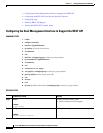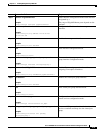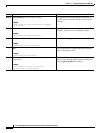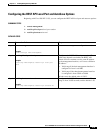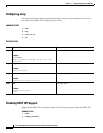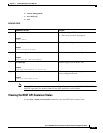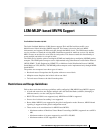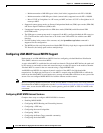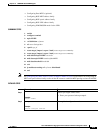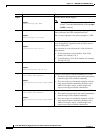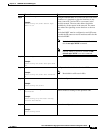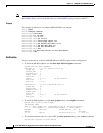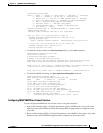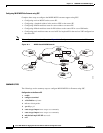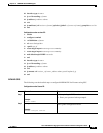
18-2
Cisco ASR 1000 Series Aggregation Services Routers Software Configuration Guide
OL-16506-17
Chapter 18 LSM-MLDP-based MVPN Support
–
Maximum number of MLDP ingress labels (local labels) supported on each PE is 100,000.
–
Maximum number of MLDP egress labels (remote labels) supported on each PE is 100,000.
–
Max of 32 PE or P neighbors in a PE router per MDT, and max of 33 PE or P neighbors in a P
router per MDT.
• Supported content group modes are Protocol Independent Multicast (PIM) sparse mode (PIM-SM)
and Source Specific Multicast (SSM) traffic.
• Unsupported content group modes are PIM dense mode (PIM-DM) and bidirectional PIM
(bidir-PIM) traffic.
• The PIM-sparse content group mode is supported if the RP is configured behind the PE router (on
CE). The RP and the source router have to be in the same VRF and PE site with the same RPF
interface.
• For RPF lookup in the context of the extranet, only the ip multicast rpf select command is
supported for the configuration.
• The MLDP provides only link protection with the FRR TE. Only single hop is supported with MLDP
TE. However, the backup path can have multiple hops.
Configuring LSM-MLDP-based MVPN Support
Deployment of an LSM-MLDP-based MVPN involves configuring a default Multicast Distribution
Trees (MDT) and one or more data MDTs.
A static default MDT is established for each multicast domain. The default MDT defines the path used
by PE routers to send multicast data and control messages to other PE routers in the multicast domain.
A default MDT is created in the core network using a single MP2MP LSP.
An MLDP-based MVPN also supports dynamic creation of data MDTs for high-bandwidth
transmissions. For high-rate data sources, a data MDT is created using the P2MP LSPs to offload the
traffic from the default MDT to avoid unnecessary wastage of bandwidth to PEs that are not a part of the
stream. You can configure MLDP MVPN for both the intranet and the extranet.
Note Before configuring MLDP-based MVPN, ensure that the MPLS is enabled on the core facing interface.
For information on MPLS configuration, see the Cisco IOS Multiprotocol Label Switching Configuration
Guide. Also, ensure that the BGP and any interior gateway protocol (OSPF or ISIS) is enabled on the
core router.
Configuring MLDP MVPN Intranet Services
Complete these steps to configure MLDP MVPN for intranet:
• Enabling MPLS MLDP
• Configuring MVPN Routing and Forwarding instance
• Configuring a VRF entry
• Configuring the route distinguisher
• Configuring VPN Id
• Configuring the Route-Target extended community
• Configuring the default MDT



